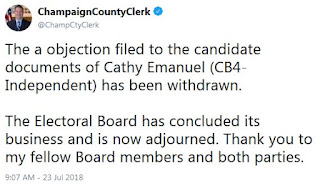The
Champaign County Sustainability Network (or CCNet) had a presentation and tour of the U of I solar farm yesterday and brought out a lot of folks interested in the new county rules on solar farms. The County Board will be voting to implement those rules next month after the 30-day review period required (more on that at
this Cheat Sheet post). For a quick peek at the presentation, they provided a fact sheet and slide shows from the presentation:
Agricultural Impact Mitigation (protecting the topsoil for later use) was brought up by County Board member Pattsi Petrie who was in attendance and a discussion ensued about panel spacing and the effect on areas that get less moisture over time. There appeared to be more questions than answers on this issue at this time, however. On the tour the ground cover of plants was uniform, though growth was did appear stunted a bit under the panels compared to in between.
Morgan White, the facilitator of the presentation and tour, was asked about County rules, but it did not appear that the University was following the County's work on that closely. Petrie noted the 30 day review period and emphasized the boards need for input.
A lot of the details that were discussed can be gleaned from the
Fact Sheet. There was some discussion about the co-generation of both steam being used for heating as well as to drive turbines for electricity and a brief overview of the chilled water system (odd factoid: apparently the chilled water generators are partially steam driven, though they prioritize electric powered chillers). They have a thermal energy storage tank to help deal with intermittent power issues from energy sources such as solar that vary. The University also has a wind power purchase agreement with another site and multiple smaller solar installations.
They also discussed some other sites and projects from a biomass boiler that allows for field to flame on-site handling of material and energy production. Research and testing sites are scattered around the area, such as the
Solar Decathlon House which is available for conferences.
Land use efficiency came up, especially as it applies to spacing required for optimal fixed tilt. The optimal tilt of a single row versus multiple and the cost benefit limits of variable tilt panels were discussed. Reduction of efficiency of solar panels over time were discussed in the context of long term viability. The gist appeared to be that over a long period of time the units would still produce significant electricity, but with less efficiently in regards to cost per kilowatt as well.
Noise was discussed. The primary source of noise come from the cooling units on the inverter cabinets (where all the direct current electricity from the panels runs to and is converted to alternating current for the grid). The rural units we saw on the tour weren't insulated for sound and were similar to the noise you'd hear next to any small commercial building's rooftop AC unit. For a city dweller it may not be very annoying or noticeable depending on your situation/proximity. For folks wanting a quite country existence with nothing but the sound of nature, some sort of sound dampening and distance would probably be required. A quick video with me speaking a couple feet from the microphone at an indoor voice level (adjust volume up to hear background versus voice noise):
The inverters tend to be centralized in the middle of the panel rows for electrical and logistical reasons. In this case they're along a column road for access, down the middle of the solar farm.
There were some questions about the solar farm having an extended down time recently. This was apparently due to a parts backlog after the hurricanes last year causing a dramatic wait. Only one inverter was affected, but as they ran in series, that took the whole farm offline. The design has been modified to allow partial use in similar scenarios in the future.
The University appears to be going by the assumption that they will purchase the farm and continue to use it (and have first rights to do so) after the 10 year contract and perhaps even 25 years out. At that point it comes down to future circumstances and how cost effective it is to keep. The University therefore doesn't have any immediate concerns about decommissioning costs that the County Board does and that Petrie raised during the presentation.
When it comes to other environmental concerns like pollinators or pollinator improvements, this site is generally controlled by the vendor on those issues, though the University can encourage such improvements. They are looking at those issues more in depth for a future solar farm expansion, however. (more on pollinator issues on the Cheat Sheet
here).
There was a discussion towards the end of the presentation about land use efficiency, both in the context of killowatts produced, but also economic and agricultural production. Wind farms do take up space around each turbine that adds up, even though it's spaced out, whereas solar farms are necessarily condensed in their land usage. Wind has overall advantages here, but the disadvantages are that wind blows more at night and more in winter... which aren't peak electrical usage times, generally. Proximity and ability to connect to the grid plays a role as well.






















